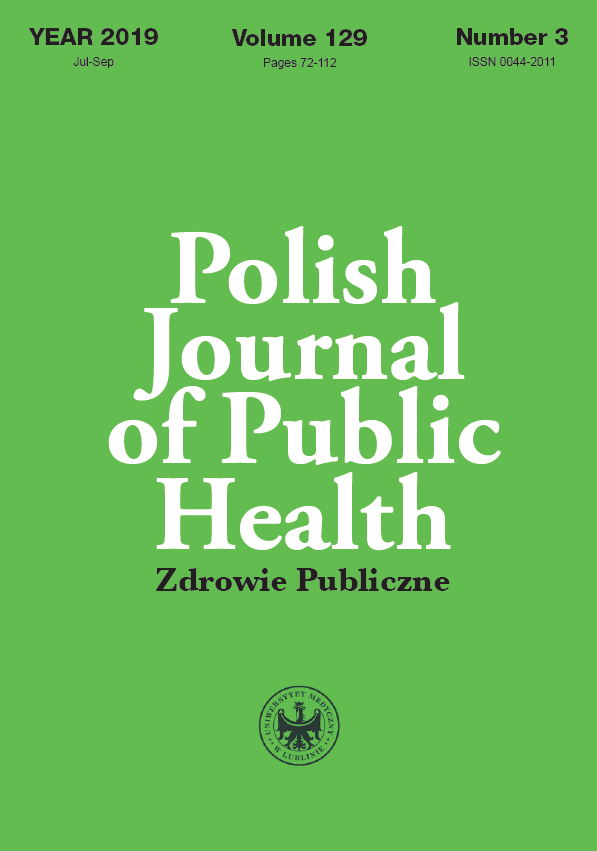Self-esteem of medical students and their attitudes towards the nurse profession
DOI:
https://doi.org/10.2478/pjph-2019-0023Keywords:
self-esteem, medical students, nurse professionAbstract
Introduction. The profession of a nurse is next to the medical profession, one of the pillars of medical care in Poland and in the world. In recent years, the need to see the importance of this profession and the responsibility associated with it, both by the public and the doctors, is increasingly underlined.
Aim. The research carried out is an attempt to answer the question, what attitudes towards nurses are shaped by future doctors already during the studies and what influence on students’ self-esteem on these attitudes.
Material and methods. The research was conducted among 89 students of the medical faculty, Medical University in Lublin in April 2018. A questionnaire of own authorship was used, constructed on the basis of descriptive research carried out by Maik M. et al and the Rosenberg Self-Assessment Questionnaire (SES). The obtained results were subjected to statistical analysis using the STATISTICA program, version 13.1.
Result. The vast majority of medical students (80%) believe that the role of a nurse is underestimated both in society and in the medical community. Students think that this work requires sacrifice and constant vigilance. Students who have encountered nursing staff notice symptoms of burnout in some of them, such as depersonalization of patients (56%). However, most of them (60%) think that this is ungrateful work and often interferes with family life. Students do not agree that the nurse should always be smiling and optimistic (75%). She values her features such as patience, good organization of time (86%) and ability to cooperate with doctors (91%). Most of students think that a nurse is a partner of a doctor (73%), while almost half (49%) of them see imperfections in cooperation both professional groups, resulting from the lack of mutual respect (64%). Students notice the commitment and hard work performed by nurses (70%), and also, although to a lesser extent, they appreciate their knowledge (56%).
Conclusion. Appreciation of the nurse’s role on the part of doctors seems to be particularly important due to the need for cooperation of medical staff. The quality of cooperation between the interdisciplinary team and, consequently, the quality of care and medical care depends to a large extent on the mutual respect, understanding and correct communication between these professional groups.
References
1. Naczelna Izba Pielęgniarek i Położnych. Raport Naczelnej Rady Pielęgniarek i Położnych: Zabezpieczenie społeczeństwa polskiego w świadczenia pielęgniarek i położnych. Warszawa: Naczelna Izba Pielęgniarek i Położnych; 2017. http://nipip.pl/wpcontent/uploads/2017/03/Raport_druk_2017.pdf (access: 25.05.2018).
2. Urbanek B. Zmaganie o profesję w XIX i XX wieku. In: B. Urbanek (ed.) Zawód pielęgniarki na ziemiach polskich w XIX i XX wieku. Warszawa: Wyd. Makmed; 2008. p. 56-79.
3. Dobińska Ż. Historia i etos zawodu pielęgniarki w Polsce. Pol Prz Nauk Zdrowiu. 2014;2(39):172.
4. PAP/Rynek Zdrowia; 27 marca 2017. http://www.rynekzdrowia.pl/Polityka-zdrowotna/Radziwill-musimy-pracowac-nad-prestizem-zawodow-pielegniarki-i-poloznej,171471,14.html (access: 25.05.2018).
5. Koralewicz DE, Kuriata-Kościelniak E, Mróz S. Opinia studentów pielęgniarstwa na temat wizerunku zawodowego pielęgniarek w Polsce. Piel Zdr Publ. 2017;7(4):285-92.
6. Baumann, K. Świadomość samego siebie. Eduk Dialog. 2005;10:7-31.
7. Szpitalak M, Polczyk R. Samoocena. Geneza, struktura, funkcje i metody pomiaru. Kraków: Wydawnictwo Uniwersytetu Jagiellońskiego; 2015.
8. Niebrzydowski L. Psychologia wychowawcza – samoświadomość, aktywność, stosunki interpersonalne. Warszawa: Wydawnictwo PWN; 1989.
9. Janiszewska-Nieścioruk Z. Samoocena, samoocena dzieci i młodzieży z niepełnosprawności intelektualną. In: T. Pilch (ed.) Encyklopedia pedagogiczna XXI wieku. Warszawa: ŻAK; 2006.
10. Szewczuk W. Słownik psychologiczny. Warszawa: Wydawnictwo Wiedza Powszechna; 1985.
11. Aronson E, Akert R, Wilson T. Psychologia społeczna – serce i umysł. Poznań: Wydawnictwo Zyski S-ka; 1997.
12. Wells LE, Marwell G. Self-esteem: Its conceptualization and measurement. Beverly Hills: CA; 1976.
13. Smelser NJ. Overview of the ten-year report on the behavioral and social sciences. Sociol Perspect. 1989;32(1):1-4.
14. Wojciszke B. Człowiek wśród ludzi. Zarys psychologii społecznej. Warszawa: Wydawnictwo Naukowe Scholar; 2002.
15. Niebrzydowski L. Rodzaje samooceny uczniów klas V-VIII. Psychol Wychow. 1974;4:432-45.
16. Szpitalak M, Polczyk R. Samoocena. Geneza, struktura, funkcje i metody pomiaru. Kraków: Wydawnictwo Uniwersytetu Jagiellońskiego; 2015.
17. Dzwonkowska I, Lachowicz-Tabaczek K, Łaguna M. Samoocena i jej pomiar (SES), polska adaptacja skali SES M. Rosenberga. Podręcznik. Warszawa: PTP; 2008.
18. Maik M, Marcinowicz L, Zarzycka D, et al. Zawód pielęgniarki w opinii studentów medycyny. Pielęg XXI wieku. 2009;3(28):23-30.
19. Fejfer-Wirbał E, Gładczuk J, Marcinowicz L. Relacje lekarz-pielęgniarka w polskiej literaturze medycznej. Med Rodz. 2013;1:19-22.
20. Włodarczyk D, Tobolska B. Wizerunek zawodu pielęgniarki z perspektywy lekarzy, pacjentów i pielęgniarek. Med Pr. 2011;62(3):269-79.
21. Ma C, Stimpfel AW. The association between nurse shift patterns and nurse-nurse and nurse-physician collaboration in acute care Hospital Units. J Nurs Adm. 2018;48(6):335-41.
22. Siwek M, Nowak-Starz G. Współczesny wizerunek pielęgniarstwa w opinii społeczeństwa. Pielęg Pol. 2017;3(65):487-500.
23. House S, Havens D. Nurses’ and Physicians’ Perceptions of Nurse-Physician Collaboration. JONA. 2017;47(3):165-71.
24. Matziou V, Vlahioti E, Perdikaris P, et al. Physician and nursing perceptions concerning interprofessional communication and collaboration. J Interprof Care. 2014;28(6):526-33.
Downloads
Published
Issue
Section
License
Copyright (c) 2020 Polish Journal of Public Health

This work is licensed under a Creative Commons Attribution-NonCommercial-NoDerivatives 3.0 Unported License.


